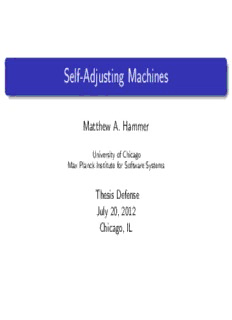
Self-Adjusting Machines PDF
Preview Self-Adjusting Machines
Self-Adjusting Machines Matthew A. Hammer UniversityofChicago MaxPlanckInstituteforSoftwareSystems Thesis Defense July 20, 2012 Chicago, IL Static Computation Versus Dynamic Computation Static Computation: Fixed Input Compute Fixed Output Dynamic Computation: Changing Input Compute Changing Output Read Write Update Changes Updates MatthewA.Hammer Self-AdjustingMachines 2 Dynamic Data is Everywhere Software systems often consume/produce dynamic data Reactive Systems Analysis of Internet Scientific Simulation data MatthewA.Hammer Self-AdjustingMachines 3 Dynamic Case (Uses update mechanism) compute 10 sec update 1×10−3 sec # of changes 1 million Total time 16.7 minutes Speedup 1000x Tractability Requires Dynamic Computations Changing Input Compute Changing Output Static Case (Re-evaluation “from scratch”) compute 1 sec # of changes 1 million Total time 11.6 days MatthewA.Hammer Self-AdjustingMachines 4 Tractability Requires Dynamic Computations Changing Input Compute Changing Output Read Write Update Changes Updates Static Case Dynamic Case (Re-evaluation “from scratch”) (Uses update mechanism) compute 1 sec compute 10 sec # of changes 1 million update 1×10−3 sec Total time 11.6 days # of changes 1 million Total time 16.7 minutes Speedup 1000x MatthewA.Hammer Self-AdjustingMachines 4 Dynamic Computations can be Hand-Crafted As an input sequence changes, maintain a sorted output. Changing Input Changing Output 1,7,3,6,5,2,4 compute 1,2,3,4,5,6,7 Remove 6 1,7,3,/6,5,2,4 update 1,2,3,4,5,/6,7 Reinsert 6, 1,7,3,6,5,2/,4 update 1,/2,3,4,5,6,7 Remove 2 A binary search tree would suffice here (e.g., a splay tree) What about more exotic/complex computations? MatthewA.Hammer Self-AdjustingMachines 5 Self-Adjusting Computation Offers a systematic way to program dynamic computations Domain knowledge + Library primitives Self-Adjusting Program The library primitives: 1. Compute initial output and trace from initial input 2. Change propagation updates output and trace MatthewA.Hammer Self-AdjustingMachines 6 High-level versus low-level languages Existing work uses/targets high-level languages (e.g., SML) In low-level languages (e.g., C), there are new challenges Language feature High-level help Low-level gap Type system Indicates mutability Everything mutable Functions Higher-order traces Closures are manual Stack space Alters stack profile Bounded stack space Heap management Automatic GC Explicit management C is based on a low-level machine model This model lacks self-adjusting primitives MatthewA.Hammer Self-AdjustingMachines 7 Thesis statement By making their resources explicit, self-adjusting machines give an operational account of self-adjusting computation suitable for interoperation with low-level languages; via practical compilation and run-time techniques, these machines are programmable, sound and efficient. Contributions Surface language, C-based Programmable Abstact machine model Sound Compiler Realizes static aspects Run-time library Realizes dynamic aspects Empirical evaluation Efficient Example: Dynamic Expression Trees Objective: As tree changes, maintain its valuation + + − − − + + 0 5 6 + 0 − 5 3 4 3 4 5 6 ((3+4)−0)+(5−6) = 6 ((3+4)−0)+((5−6)+5) = 11 Consistency: Output is correct valuation Efficiency: Update time is O(#affected intermediate results) MatthewA.Hammer Self-AdjustingMachines 9
Description: